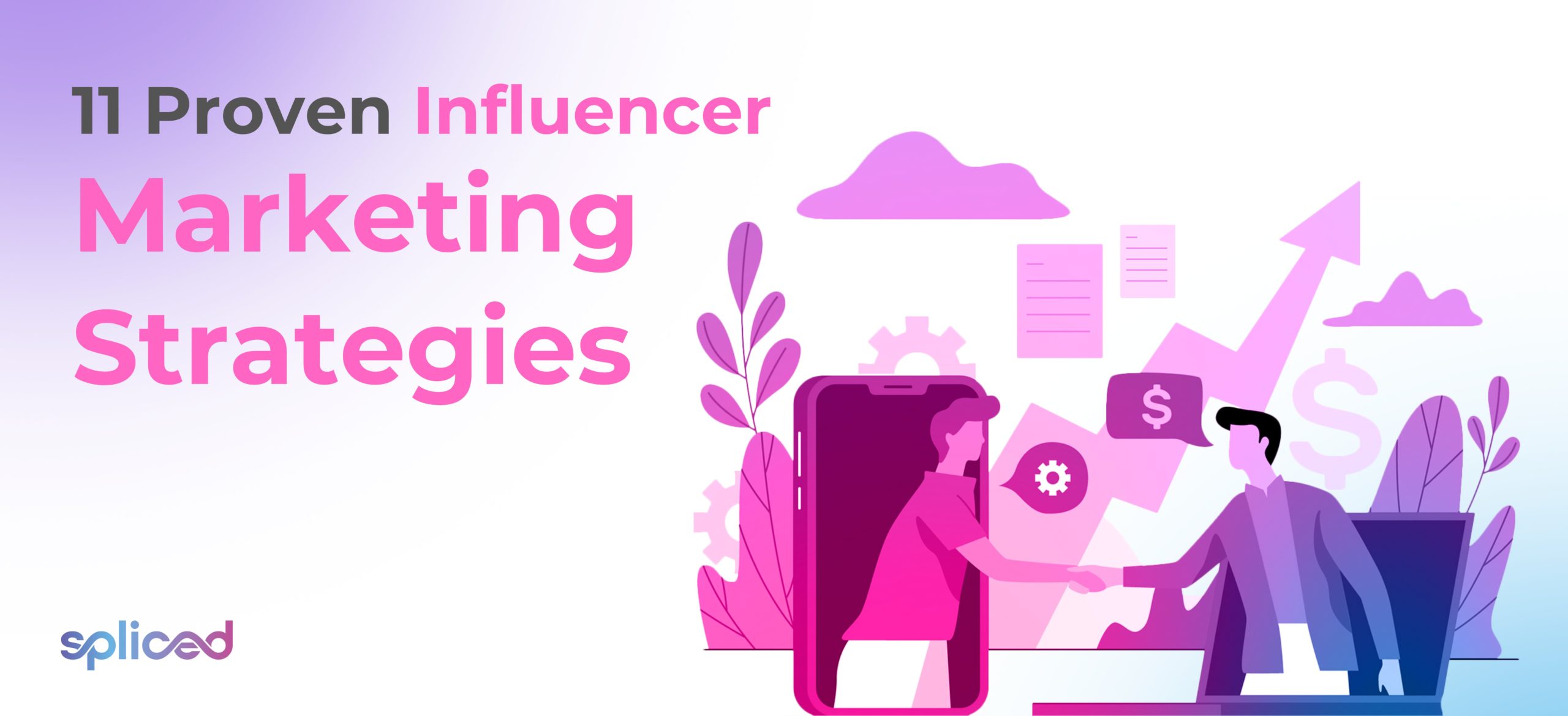Influencers have risen in today’s digital era. Influencers are individuals who hold sway over a considerable number of online followers, guiding opinions and driving conversations in niche communities. Influencer’s authority stems from their authenticity, expertise, or sheer charisma in their chosen field. Influencer marketing taps into influential figures to promote products and services, leveraging the trust influencers have established with their audience.
Smaller brands eager to harness the power of the strategy need to gather influencer marketing tips. One tip is to begin by establishing firm goals that act as a roadmap for the campaign. Another is understanding the target audience, as it ensures that the campaign’s tone and content create a deep resonance with prospective new users. Budgeting anchors the campaign’s scope, ensuring efficient and wise resource allocation.
Choosing the appropriate campaign type shapes the narrative and the audience’s interaction with it. Determining the right social media platform ensures the campaign reaches the target market. Content development must be meticulous so it reflects the brand’s voice and resonates with the influencers and their followers.
Building genuine relationships with influencers leads to successful influencer marketing. Campaign promotion increases its visibility and fosters a positive community around it, securing longevity and loyalty. Give strategies space to breathe as they take time to evolve and for results to manifest.
Tracking success is another good tip. Tracking provides insights to help with further refinements and improve future campaigns. The tips and strategies are evidence of how significant and deep influencer marketing is in today’s online-centric age.
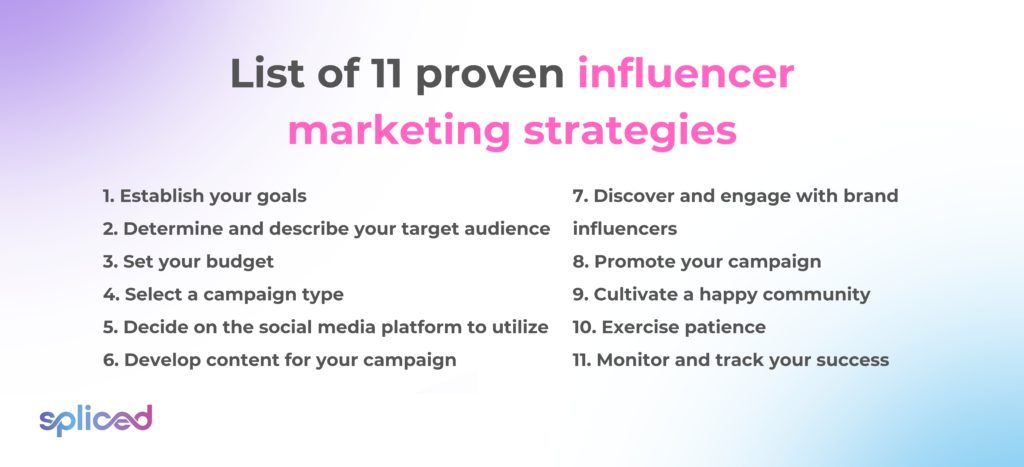
Listed below are 11 proven influencer marketing strategies.
- Establish your goals: Setting clear goals and objectives provides a roadmap for the entire campaign, ensuring every action aligns with the desired outcomes. Goals offer direction, helping teams prioritize tasks and allocate resources better. Campaigns risk losing focus and falling below expectations without well-defined goals.
- Determine and describe your target audience: Every influencer marketing campaign must cater to a specific group. Knowing the group inside and out ensures the campaign resonates on a personal level. An intimate understanding of the target audience allows for tailored messaging, increasing the chances of genuine engagement. A campaign that connects with its audience has a higher chance of achieving its objectives.
- Set your budget: A well-defined budget grounds campaigns, ensuring that spending aligns with goals and expected outcomes. It aids in making informed decisions, from selecting influencers to choosing promotional tactics. A thoughtful budget prevents overspending and maximizes the return on investment.
- Select a campaign type: The right campaign type delivers the desired message in the most effective manner. The campaign type sets the tone and manner of interaction with the target audience. Tailoring the campaign type to the goals and audience preferences increases the likelihood of success.
- Decide on the social media platform to utilize: There are different types of social media platforms and each one has a unique environment that caters to different demographics and interests. Choosing the right platform ensures the message meets the audience where they are most active and engaged. It streamlines the communication process, increasing the campaign’s efficiency and effectiveness.
- Develop content for your campaign: Crafting engaging and relevant content captures the audience’s attention and encourages interaction. Quality content fosters trust, which forms the basis for lasting relationships with the audience. Campaigns communicate the desired message through clear and persuasive content.
- Discover and engage with brand influencers: Influencers act as the face of the campaign, lending credibility and extending reach. Building genuine relationships with the right influencer amplifies the campaign’s message. A trusted influencer’s endorsement resonates with their followers, driving engagement and conversions. Collaboration with appropriate influencers makes campaigns relatable and impactful.
- Promote your campaign: Strategic promotion of the campaign captures the attention of a broader audience. Promotion amplifies the message, driving engagement and encouraging virality. Effective promotion strategies keep the campaign’s message relevant and prevent it from getting lost in the algorithm.
- Cultivate a happy community: The sentiment of the community matters. An engaged and satisfied community acts as advocates who amplify the campaign’s message. Fostering positive interactions and addressing concerns builds loyalty and trust. A happy community becomes a reservoir of support that drives sustained success for future campaigns.
- Exercise patience: Influencer marketing takes time. It builds momentum and gathers insights. Rushing processes or expecting immediate results detracts from the campaign’s potency. Giving a campaign time to mature ensures that strategies evolve and relationships deepen, leading to the desired outcome.
- Monitor and track your success: Monitoring the progress and outcomes of a campaign provides invaluable insights. Tracking success helps determine what works and what needs adjustments. Regular evaluations ensure campaigns remain on track and strategies get refined for better results in future efforts.
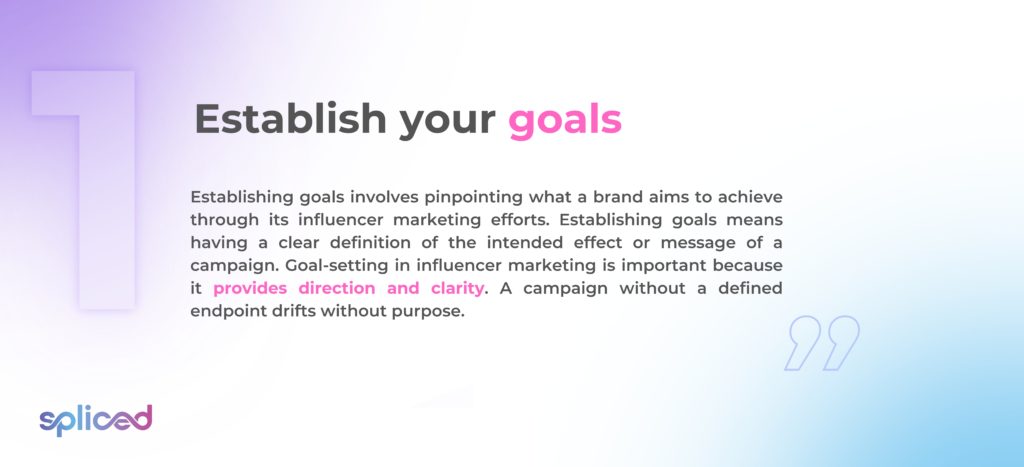
1. Establish your goals
Establishing goals involves pinpointing what a brand aims to achieve through its influencer marketing efforts. Establishing goals means having a clear definition of the intended effect or message of a campaign. Goal-setting in influencer marketing is important because it provides direction and clarity. A campaign without a defined endpoint drifts without purpose.
Establishing goals prevents wasted resources and missed opportunities. Goals act as the anchor that grounds every strategic move and decision to ensure they contribute to the desired outcome. Start by envisioning the broad outcome, then narrow it down to more tangible metrics or targets.
The more precise and measurable the goals, the more actionable they become. For example, a vague aim such as “boost brand awareness” transforms into a concrete goal like “achieve a 20% increase in brand mentions over the next six months.”
Establishing clear goals provides a clear roadmap for the campaign so that every team member understands their role and contribution. Measuring success becomes objective and straightforward with set goals. Goals offer a clear benchmark that allows brands to assess the effectiveness of their influencer partnerships. Another advantage is that goals are motivators that drive teams to push boundaries and strive for excellence.
A disadvantage of goal establishment is the overemphasis on certain goals. Obsessing on a specific metric blinds a brand to emerging opportunities outside their predefined parameters. Too much focus on a specific outcome leads to neglecting other essential aspects of a campaign.
Establishing goals is important, but brands must remain adaptable and flexible. Adaptability and flexibility allow brands to course-correct when issues arise while still accomplishing the desired outcome.
For example, a cosmetic brand has the broad goal of promoting a new skincare product line. The cosmetic brand then narrows its goal to enhancing product visibility and recall among millennials. The specific goal allows brands to make the strategic move of partnering with beauty influencers in the age group of 20–30 for the best effect. Choosing the appropriate influencers allows the brand to achieve its goal while creating a foundation of trust among its target audience.
Establishing goals is a cornerstone of all marketing strategies, including influencer marketing. It equips brands with a sense of direction and provides a standard against which success is evaluated. Effective goal establishment and adherence steer influencer marketing endeavors towards tangible success.
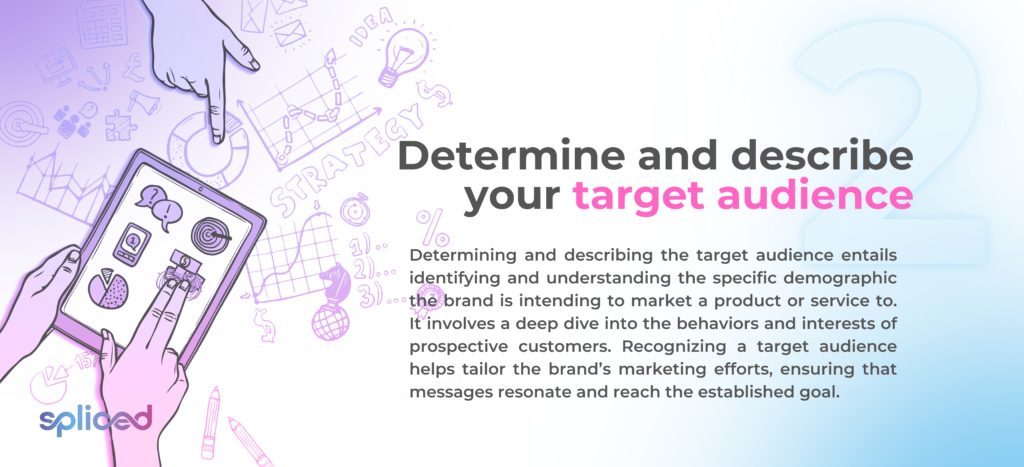
2. Determine and describe your target audience
Determining and describing the target audience entails identifying and understanding the specific demographic the brand is intending to market a product or service to. It involves a deep dive into the behaviors and interests of prospective customers. Recognizing a target audience helps tailor the brand’s marketing efforts, ensuring that messages resonate and reach the established goal.
A precise understanding of a target audience is crucial in resource management. Brands spend time and money to engage with their audience. Knowing precisely with whom to engage ensures that the resources find optimal use. Determining the target audience allows for tailored messages that amplify positive reception, getting the audience to act upon the call to action.
Determining and describing a target audience starts with data collection. Brands gather insights from current customers through market research. Brands analyze social media and website analytics to aid in the process.
Segmenting the audience based on various criteria allows for a clearer picture. For example, location or age are two ways to segment an audience. Creating detailed profiles, or personas, for each segment helps visualize the ideal customer.
Determining and describing the target audience aids in crafting resonant messages that capture attention and incite action. Another advantage is its help in selecting the right influencers who mirror the brand’s audience. The process guides product development to ensure that offerings align with audience needs and desires.
An overly narrow focus on a specific audience segment, on the other hand, risks missing out on broader market opportunities. Excessive reliance on data misses the nuances of human behavior. Regular reassessment is necessary as audience preferences and behaviors change over time.
Take a fitness apparel brand aiming to market a new line of workout clothing as an example. The brand’s market research identifies their target audience as women aged 25 to 40 who engage in regular fitness activities and value comfort and durability in athletic wear. The brand uses the information to approach fitness influencers who cater to a similar demographic for the best results.
Determining and describing a target audience acts as a guiding star. It ensures relevance and optimizes the reach and impact of every marketing effort. Determining and understanding a target audience is a foundational element in the success of any influencer marketing campaign.
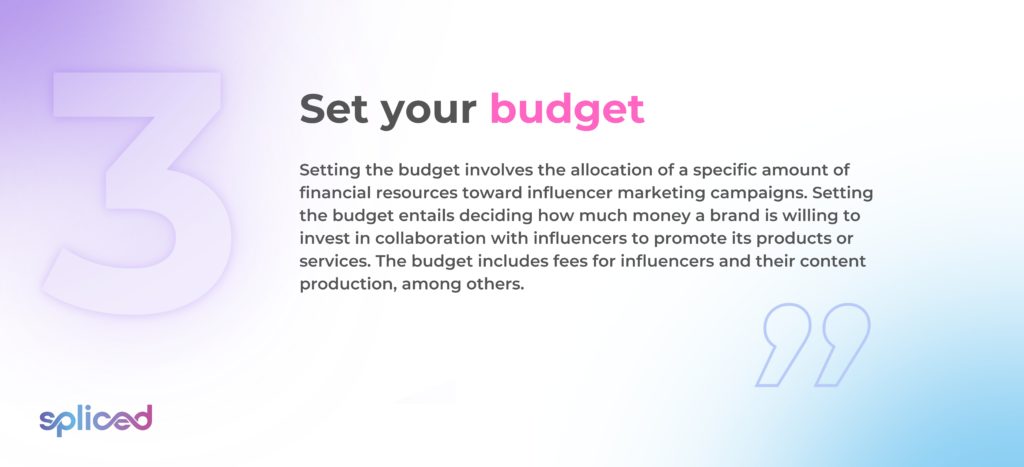
3. Set your budget
Setting the budget involves the allocation of a specific amount of financial resources toward influencer marketing campaigns. Setting the budget entails deciding how much money a brand is willing to invest in collaboration with influencers to promote its products or services. The budget includes fees for influencers and their content production, among others.
Setting a clear budget for influencer marketing offers a roadmap for brands. It ensures efficient resource allocation and financial responsibility. Brands risk overspending or underspending without a set goal. Overspending affects profitability, and underspending diminishes the campaign’s effectiveness.
Setting the budget starts with a review of the brand’s financial capabilities and understanding its marketing objectives. The review must factor in all costs, even minor ones. Brands allocate funds to each identified area to ensure coverage in every aspect of the campaign. Regular monitoring and adjustments to the budget throughout the campaign ensure the optimal utilization of funds.
Setting a clear budget presents several advantages. It keeps brand’s spending within the confines of their resources. Knowing the financial limitations informs its decision-making better. A set budget serves as a point of comparison to measure a campaign’s result and the return on investment.
Drawbacks include the set budget’s rigidity. Brands miss out on valuable opportunities that arise mid-campaign but require additional funds. Another drawback of a fixed budget is that it limits creativity, causing hesitancy to try innovative approaches.
For example, a brand is launching a new product line after reviewing its finances and campaign objectives. The brand allocates $20,000 for its influencer marketing strategy. The brand keeps that allocation in mind and decides to collaborate with five micro-influencers for $3,000 each, with the remaining $5,000 set aside for content production and advertising.
Having a set budget allows for easier decision-making when unexpected circumstances arise. For example, the brand uses the set budget to evaluate whether or not an unforeseen opportunity is worth it. Setting a budget acts as a safeguard and a guide. It ensures financial prudence while providing a framework for strategic decisions.
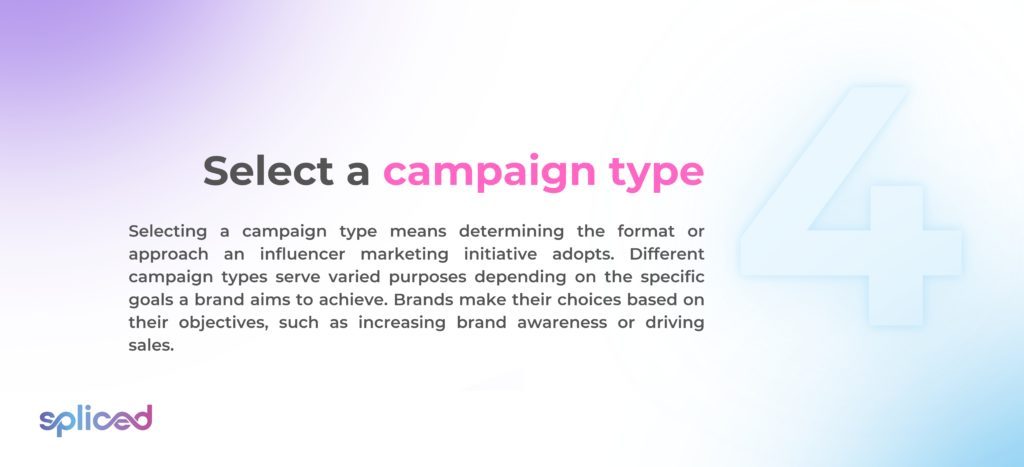
4. Select a campaign type
Selecting a campaign type means determining the format or approach an influencer marketing initiative adopts. Different campaign types serve varied purposes depending on the specific goals a brand aims to achieve. Brands make their choices based on their objectives, such as increasing brand awareness or driving sales.
Selecting the appropriate campaign type is key to the success of any influencer marketing strategy. Each type of campaign resonates with different audiences and influences their perception and behavior in distinct ways. Brands benefit from tailoring their campaigns to create an authentic connection with their target demographic.
Campaign types have several forms. One example is a product review campaign. Influencers receive products from brands and share genuine reviews with their audience. Product reviews provide audiences with real insights that help them make informed purchasing decisions.
Another popular campaign type is giveaways. Brands partner with influencers to host contests or raffles where audience members have a chance to win products or services. Giveaway campaigns stir excitement and engagement that encourage active participation from audience members.
Each campaign type has its advantages. For example, product review campaigns build trust. They offer transparent views of products that help prospective customers understand the benefits and shortcomings. Giveaway campaigns, on the other hand, drive audience engagement that creates a buzz around the brand and its offerings.
Disadvantages need to be weighed for each campaign type. Product review campaigns run the risk of receiving negative feedback. An influencer’s honest critique has the risk of highlighting issues a brand hadn’t anticipated. Giveaway campaigns have the risk of creating superficial engagement, where audiences are interested in the prize but not the brand.
For example, a renowned skincare brand wants to launch a new moisturizer. They partner with beauty influencers for a product review campaign. Influencers test the moisturizer first, then share their experiences and give feedback after. Audiences gain insights into the moisturizer’s texture and effectiveness, along with its suitability for different skin types.
Another example is a budding athleisure company that collaborates with fitness influencers for a giveaway campaign. The brand and the influencers design a contest where participants share their fitness journey stories. Winners receive an entire athleisure outfit. The campaign garners significant attention, creating engagement and new followers for the brand and the influencers.
Selecting a campaign type dictates the trajectory of the campaign and influences audience reception and engagement. Brands need to consider their goals and weigh the pros and cons. Choosing a campaign type that aligns best with their objectives leads to profitable results.
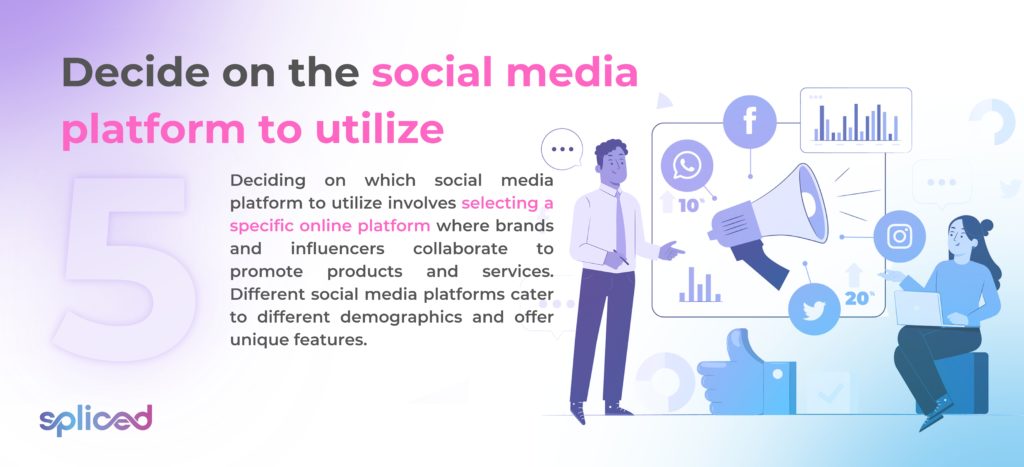
5. Decide on the social media platform to utilize
Deciding on which social media platform to utilize involves selecting a specific online platform where brands and influencers collaborate to promote products and services. Different social media platforms cater to different demographics and offer unique features. The decision to utilize a specific social media platform allows brands to target their audience and users and formulate appropriate campaign goals.
Selecting the right platform leads to better effectiveness in influencer marketing campaigns. Each platform attracts a unique user base, has its own content style, and provides varied engagement tools. The platform serves as the bridge between a brand and its desired audience. An inappropriate choice leads to diminished returns on investment and a risk of disconnection from the target market.
The decision process involves understanding on which platform the target demographic spends most of their time online and assessing which platform aligns with the campaign’s content type. For example, Instagram caters to a younger audience and focuses on visual content, including photos and short videos. LinkedIn, on the other hand, targets professionals and emphasizes industry news, professional achievements, and thought leadership.
Deciding on the right social media platform to utilize has various advantages. The best-fitting platform ensures that content reaches the intended audience, resulting in higher engagement rates. For example, Instagram focuses on visuals that work wonders for lifestyle and beauty brands. Twitter emphasizes real-time updates, which serves well for brands aiming to tap into current events or trends.
Disadvantages include the mismatch between the selected platform and the employed influencer. Every influencer has a strong presence on specific platforms, but not all. A brand that chooses a social media platform where its chosen influencer lacks a strong following faces decreased visibility. Another disadvantage is platforms’ continuous evolution of their algorithms, which affect content visibility and engagement.
For example, consider a luxury watch brand aiming to showcase its craftsmanship. Brands have better results when choosing Instagram. Instagram is great at visual storytelling, making it an ideal choice for quality highlights. High-definition photos and videos of the watch showing its intricate details resonate with the audience, compelling them to explore further.
Another example is a software company launching a tool for corporate communication. Selecting LinkedIn as the platform results in more value and profitability for the company. Articles posted on LinkedIn detailing the software’s features reach the appropriate audiences, and testimonials from industry leaders drive interest and trust.
Deciding on the right social media platform to utilize is about understanding where a brand’s voice finds the most resonance and where its stories weave into the daily lives of its audience. It’s the process of finding a social media platform that aligns with the brand’s values. Making a judicious choice ensures that every piece of content finds its rightful audience, turning passive viewers into active participants in a brand’s narrative.
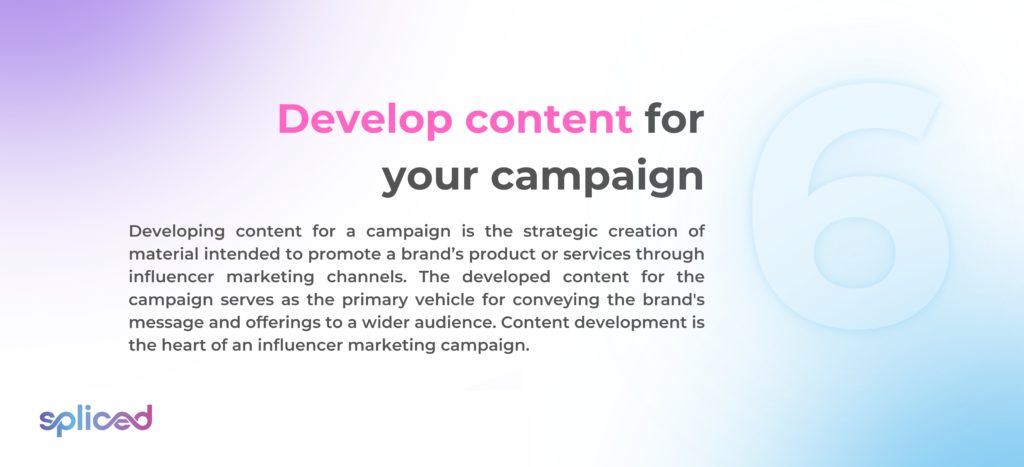
6. Develop content for your campaign
Developing content for a campaign is the strategic creation of material intended to promote a brand’s product or services through influencer marketing channels. The developed content for the campaign serves as the primary vehicle for conveying the brand’s message and offerings to a wider audience. Content development is the heart of an influencer marketing campaign.
Influencers with vast followings struggle with effective engagement with their audience if they don’t have compelling and relevant material. The best content informs and entertains. It persuades and sways audiences to act upon a call to action. Content acts as the bridge between a brand and its target demographic, ensuring the brand’s voice resonates with prospective customers.
The development of content starts with understanding the brand’s goals and target audience. Brands and influencers collaborate to craft content that aligns with the identified objectives and the influencer’s style. For example, a beauty brand launching a new line of vegan cosmetics needs content that highlights the product’s cruelty-free attributes. An influencer known for promoting sustainable products becomes the perfect fit to develop tutorials or reviews showcasing these cosmetics.
Developing content alongside the influencer has several advantages. It allows the creation of tailored messaging. Brands convey the desired message through trusted voices in the industry instead of relying on generic advertisements. Customized content resonates deeper with audiences, leading to higher engagement rates.
Leveraging the influencer’s understanding of their audience is another advantage. Influencers know what their followers love, and that ensures the content they co-create with brands hits the mark. The risk of inauthenticity is a disadvantage. Any content that appears too promotional or out of sync with the influencer’s usual style faces rejection from followers.
Brands must strike a balance between their messaging and the influencer’s authenticity. Another challenge is maintaining consistency. Different influencers have different styles. A brand collaborating with multiple influencers needs a consistent overarching theme for its campaign.
For example, a travel agency is promoting exotic holiday packages. The agency collaborates with travel influencers to co-create content. One influencer shares a vlog detailing their experiences with the package, showcasing beautiful landscapes and thrilling activities.
Another influencer writes a blog post that tells a story about the serene moments they experienced during the trip. The vlog and blog are two different formats but revolve around the same theme of experiencing unparalleled beauty and adventure with the travel agency’s package.
Content development fuses the brand’s message with the influencer’s voice. The fusion results in compelling material that appeals to the target audience. Brands turn developed content into a powerful tool that amplifies their reach and impact through collaboration and a keen understanding of the audience.
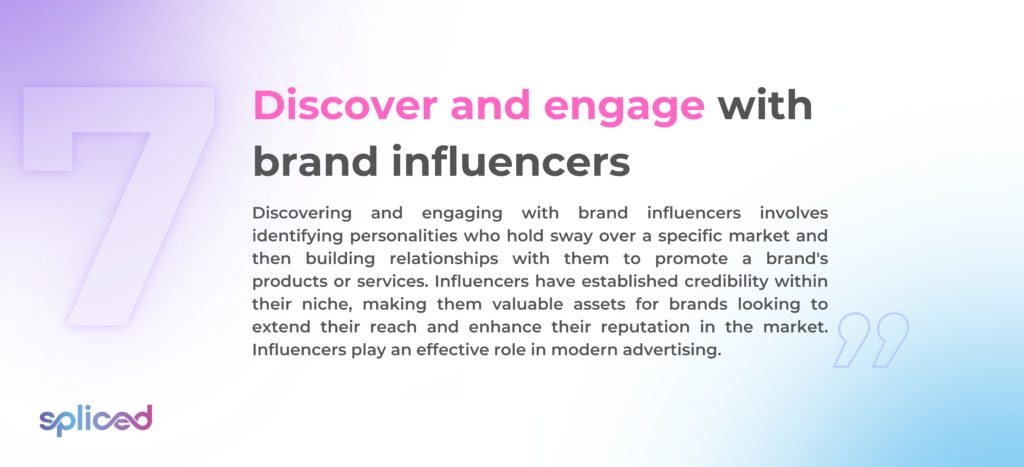
7. Discover and engage with brand influencers
Discovering and engaging with brand influencers involves identifying personalities who hold sway over a specific market and then building relationships with them to promote a brand’s products or services. Influencers have established credibility within their niche, making them valuable assets for brands looking to extend their reach and enhance their reputation in the market. Influencers play an effective role in modern advertising.
Discovering brand influencers and engaging them is important, as consumers prefer authentic and relatable recommendations over traditional advertisements. Influencers provide brands with an avenue to converse in a more organic manner. An endorsement from a trusted influencer carries weight and has more effective persuasion power over audiences.
Discovering and choosing which brand influencers to engage with starts with thorough research. Brands must have a full understanding of their target audience to find influencers who resonate with that demographic. Various tools and platforms aid brands in filtering and finding influencers based on factors including reach and engagement rate.
Brands approach and start engagement with the identified influencers and propose collaboration. A collaboration proposal is best if it’s a win-win agreement that ensures benefits for the brand and influencer.
For instance, a high-end fashion brand looking to promote a new collection connects with a fashion influencer with a significant following among young adults. The brand approaches the influencer with an offer to send them pieces from the new collection. The influencer provides a review or a series of posts in exchange.
Engaging with influencers offers several advantages. It amplifies a brand’s reach, tapping into audiences that traditional marketing strategies find hard to penetrate. It adds authenticity to the brand’s message, given that the recommendation comes from a trusted voice. It provides a cost-effective way to generate high-quality content, as influencers produce and share the material themselves.
Risks are unavoidable, which is why brand’s and influencer’s values and targets must align. For example, any discrepancy risks damaging the brand’s reputation. Another risk is unpredictability.
An influencer’s misstep or controversy has ramifications for associated brands. Measuring the exact return on investment from influencer collaborations is a challenge due to their complexity. Brands must use advanced tracking tools and metrics for an accurate evaluation of their influencer marketing campaigns.
Take the case of a skincare brand aiming to break into the organic product market as an illustration. The brand identifies an influencer who promotes natural and sustainable living. They start engaging with the influencer by sending over a set of their new organic skincare range. The influencer then creates a series of videos demonstrating the products and highlighting their benefits.
The influencer’s followers are already inclined toward organic products. The brand’s message gets a positive reception with ease. The positive reception leads to increased interest and sales for the skincare brand.
Discovering and engaging with brand influencers is a surefire strategy for authentic connections with the desired audience. Brands take advantage of the built-in audience of Brand Influencers in the field. Influencer marketing offers brands a potent tool to bolster their market presence and drive sales through careful selection and collaboration.
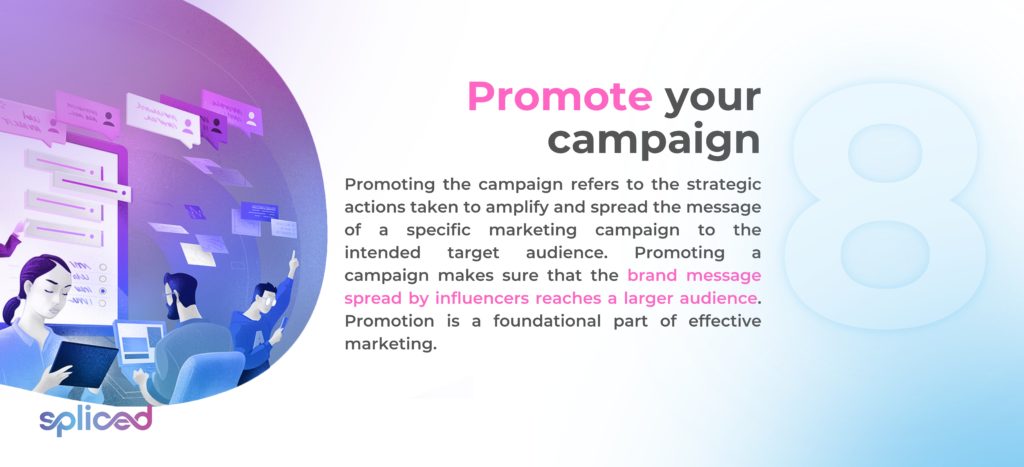
8. Promote your campaign
Promoting the campaign refers to the strategic actions taken to amplify and spread the message of a specific marketing campaign to the intended target audience. Promoting a campaign makes sure that the brand message spread by influencers reaches a larger audience. Promotion is a foundational part of effective marketing.
The most well-crafted campaigns run the risk of getting lost in the vast sea of online content without proper promotion. Promoting and amplifying a campaign ensures that it gains the traction and visibility necessary to make a genuine impact on the target demographic. Brands promote campaigns using a mix of organic and paid strategies.
Organic promotion leans on the influencer’s existing audience. Influencer’s audiences allow the spread of content through word of mouth due to the inherent shareability of the content they produce. Paid promotions involve investing money to boost the visibility of a post or video, reaching audiences beyond the influencer’s immediate followers. Platforms, such as Instagram, Facebook, and YouTube offer sophisticated targeting options that allow brands to put their content in front of a very specific subset of users.
Promoting a campaign has several advantages. It amplifies the reach of the campaign, ensuring that more eyes land on the content. Another advantage is increased engagement, which leads to higher conversion rates. Promotion fosters brand recognition, as repetition ingrains the brand’s image and message in consumers’ minds.
Promotion costs are a drawback, as paid promotions are expensive if done without careful planning and targeting. Promotion has the risk of not generating a return on investment, even if it does reach the intended audience. Overpromotion carries the risk of annoying prospective customers, leading them to have a negative view of the brand. The unpredictability of algorithms is another risk to consider as social media platforms make regular changes.
For example, a cosmetics brand launches a new line of eco-friendly lipsticks. The brand collaborates with a popular beauty influencer to showcase the lipsticks in a tutorial. The brand promotes the published content through organic and paid methods.
Organic promotion includes sharing the video on the brand’s official social media pages and encouraging employees and stakeholders to do the same. The brand invests in video ads on YouTube and Instagram, targeting women between the ages of 18 and 35 who show an interest in eco-friendly products. The dual approach ensures that the video reaches a vast audience, leading to heightened awareness and increased sales of the lipstick line.
Promoting a campaign is a huge factor in the success of ad campaigns. Promotion allows brands to ensure that their collaborations with influencers reach their target audience and achieve the desired outcome. Proper promotion, combined with quality content, sets the stage for successful influencer marketing campaigns.
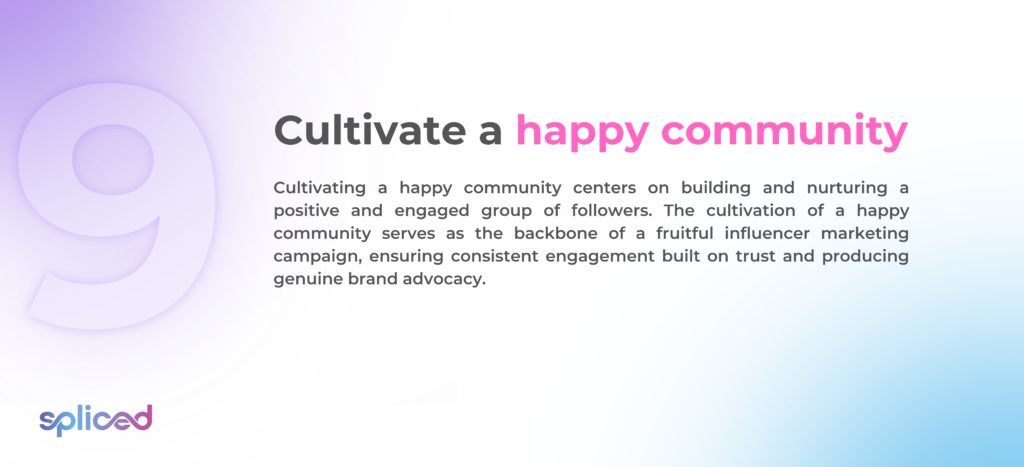
9. Cultivate a happy community
Cultivating a happy community centers on building and nurturing a positive and engaged group of followers. The cultivation of a happy community serves as the backbone of a fruitful influencer marketing campaign, ensuring consistent engagement built on trust and producing genuine brand advocacy.
A happy community increases the rate of a marketing campaign’s success. An engaged and contented audience trusts the influencer’s recommendations and provides positive reactions to brand promotions. Keeping the community happy breeds loyal brand ambassadors who spread word-of-mouth endorsements on their own, generating organic growth for the brand. A healthy community produces invaluable feedback that helps the brand and influencers fine-tune their strategies and offerings.
A happy community is built on authenticity and consistent, genuine engagement from the influencer. Authenticity ensures promotions align with the influencer’s personal brand. Consistency involves regular posting and keeping the audience informed and engaged. Genuine engagement is the influencers’ interaction with their followers, such as responding to comments and showing appreciation for their community’s support.
Cultivating a happy community has several benefits. A happy community leads to increased brand loyalty and higher conversion rates. It provides a stable platform for new product launches that ensures immediate reach and engagement. Another benefit is the protection it grants the brand and influencer from negative publicity, as loyal followers defend and support them during controversies.
Maintaining a happy community is a challenge as it demands time and resources. It requires a delicate balance of promotions and organic content to prevent the audience from feeling overwhelmed by advertisements. Another risk is mistrust and disengagement from audiences if the brand and influencer produce content that misaligns with what the community is used to.
Nike, for example, has done an effective job of cultivating a happy community around its brand. Nike creates promotions that feel authentic and trustworthy through collaborations with athletes and personalities who resonate with the brand’s ethos. Engaging content and its accompanying genuine interactions with followers have solidified Nike’s standing as a beloved brand among its community.
Cultivating a happy community creates a following that provides automatic support, which ensures success. It builds loyalty and ensures consistent engagement, which drives the success of promotional campaigns. Keeping a community is a challenge, but its benefits far outweigh the drawbacks.
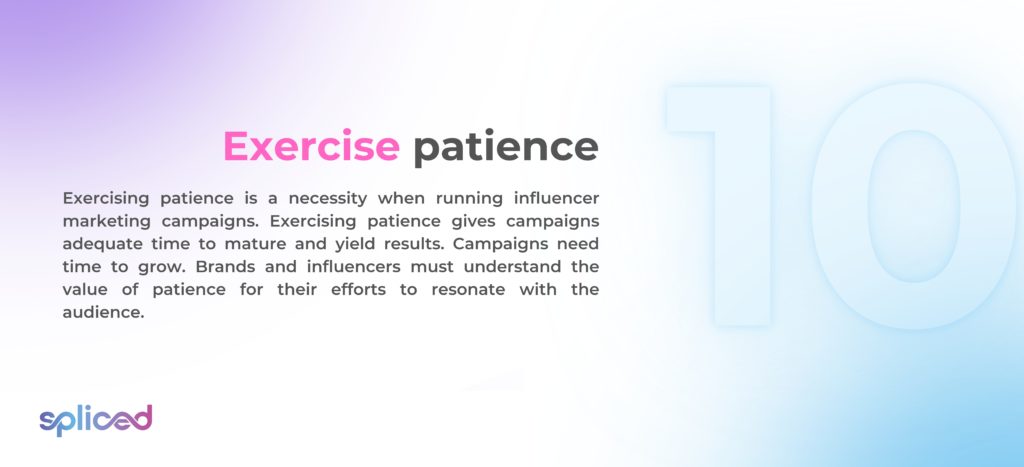
10. Exercise patience
Exercising patience is a necessity when running influencer marketing campaigns. Exercising patience gives campaigns adequate time to mature and yield results. Campaigns need time to grow. Brands and influencers must understand the value of patience for their efforts to resonate with the audience.
Influencer marketing, like many other marketing forms, doesn’t guarantee overnight success. Results take time to materialize, and mastering patience is key. Exercising patience contributes to success as it allows the building of genuine relationships.
Audiences need time to trust and familiarize themselves with the brand or product before making purchasing decisions. Rapid or aggressive promotional efforts risk overwhelming or alienating prospective customers, diminishing the campaign’s effectiveness. Working with patience involves setting realistic expectations at the outset of any campaign.
Brands and influencers must collaborate with a clear understanding of timelines and projected outcomes. Regular monitoring and assessment of the progress is vital, but it must be done without the undue pressure of immediate results. Feedback between the brand and influencer offers valuable insights to refine future strategies, but acting on them requires patience to see long-term benefits.
Exercising patience and giving a campaign space to breathe allows for organic growth and genuine brand loyalty. Giving audiences the time to engage and share feedback fosters trust and credibility. A drawback is that giving campaign time has the risk of failure or inadequacy.
A notable example of patience in influencer marketing is the collaboration between luxury brands and influencers. Luxury brands, such as Rolex or Louis Vuitton, don’t expect immediate sales spikes from their influencer partnerships. The brands instead focus on long-term brand awareness and positioning. The collaborations aim for visibility and the embedding of the brand in audiences’ minds instead of an instant increase in purchases.
Exercising patience is important in influencer marketing. Campaigns take time to yield results. Recognizing the time it takes to build trust and establish brand loyalty ensures brands and influencers set realistic expectations and work towards sustainable success.
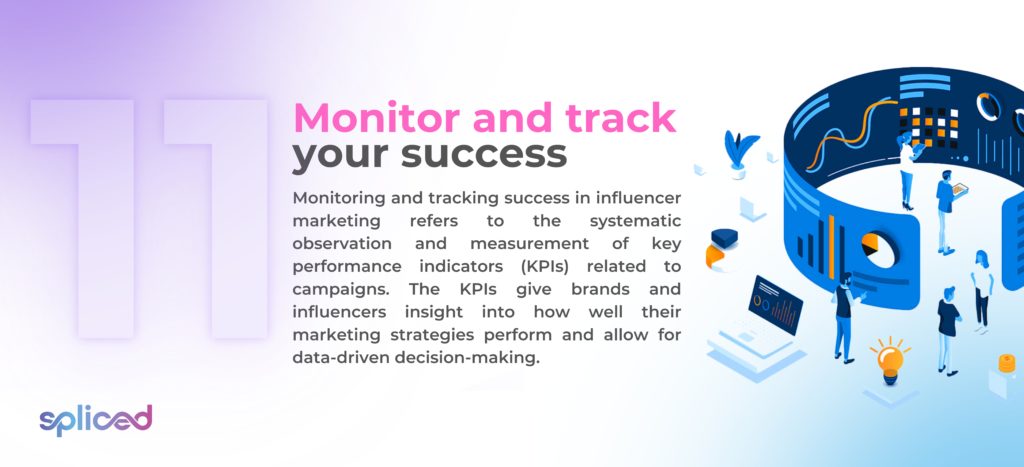
11. Monitor and track your success
Monitoring and tracking success in influencer marketing refers to the systematic observation and measurement of key performance indicators (KPIs) related to campaigns. The KPIs give brands and influencers insight into how well their marketing strategies perform and allow for data-driven decision-making.
Monitoring and tracking success is important as it ensures brands are aware of whether or not their efforts are working. Brands remain in the dark about the efficacy of their campaigns without concrete data and feedback. Successful campaigns rely on adjustments made over time, and tracking provides the necessary data for those adjustments. Constant monitoring identifies what resonates with the audience and what falls flat.
Monitoring and tracking success are done by employing a variety of tools and platforms that measure campaign metrics. The tools capture data points such as engagement rates and conversions, among others. Brands evaluate their return on investment using the metrics, helping to understand where to allocate resources in the future.
One benefit of monitoring and tracking success is the provision of actionable insights. Brands gain a clearer picture of audience preferences and trends that guide future campaigns, ensuring they align better with audience expectations. A disadvantage to consider is data overload. There’s a risk that brands fail to discern which data points matter the most, leading to missteps in strategy adjustments.
A memorable example of monitoring and tracking success is with beauty brands. The brand launches a new product line with the help of multiple influencers. Each influencer promotes the product on their platform, creating content that appeals to their unique audience. The cosmetic company then employs tracking tools to see which influencer’s content yields the highest engagement and sales conversions.
The insights gathered through metric monitoring validate the potency of a collaborator and guide future product promotion strategies. Monitoring and tracking success is a strong tool to employ with influencer marketing campaigns. It allows brands to view their campaign’s performance, allowing for more strategic decisions and adjustments if needed.
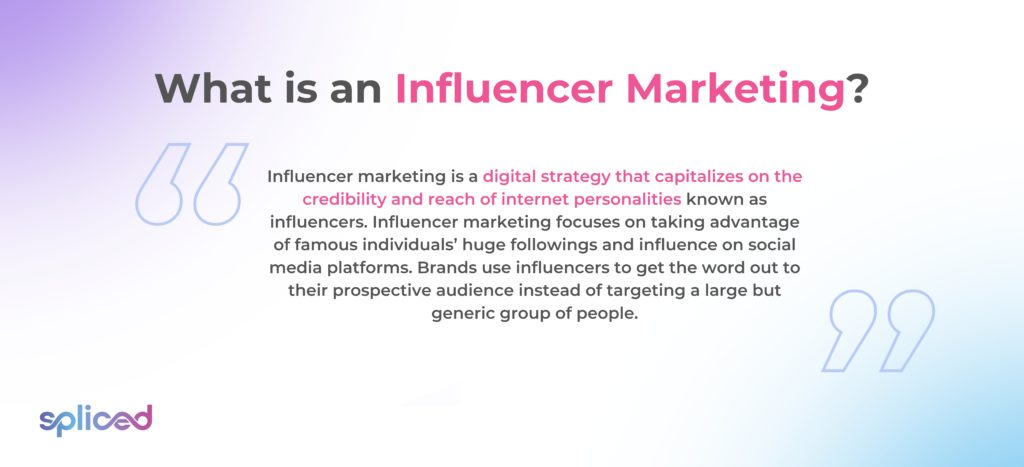
What is Influencer Marketing?
Influencer marketing is a digital strategy that capitalizes on the credibility and reach of internet personalities known as influencers. Influencer marketing focuses on taking advantage of famous individuals’ huge followings and influence on social media platforms. Brands use influencers to get the word out to their prospective audience instead of targeting a large but generic group of people.
The concept behind what is influencer marketing lies in trust and authenticity. Influencers have spent considerable time and effort building relationships with their followers. They share their daily lives, experiences, and thoughts with their audience, leading to a bond based on trust. Brands recognize the power of such genuine relationships and collaborate with influencers to promote their products or services.
Influencer marketing offers a genuine voice in a world saturated with advertisements. Brands benefit from the organic reach influencers provide. Every time an influencer mentions or showcases a product, it appears as a personal endorsement rather than a traditional advertisement. The endorsements resonate more with audiences because they come from a trusted source.
Brands and advertisers collaborate with influencers based on their audience demographics and niches. An influencer in the beauty sector promotes cosmetics and skincare products, while someone in the tech domain reviews gadgets. The alignment ensures that the promotion reaches an audience interested in the specific product or service, making the campaign more effective.
Influencer marketing stands as a strategy that offers authenticity, trust, and direct engagement in a world where consumers crave genuine interactions. Influencer Marketing has grown in popularity in recent years due to its incredible results. It remains a top choice for many brands looking to create an authentic connection with their target audience.
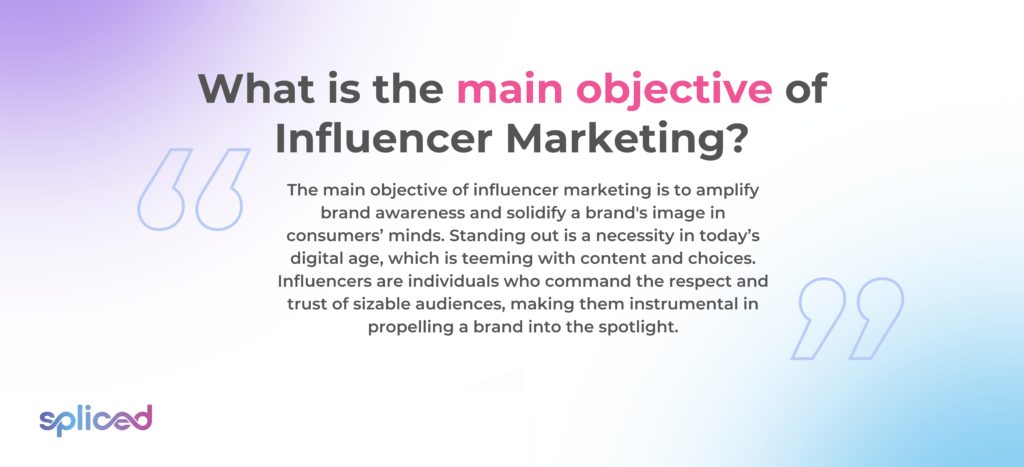
What is the main objective of Influencer Marketing?
The main objective of influencer marketing is to amplify brand awareness and solidify a brand’s image in consumers’ minds. Standing out is a necessity in today’s digital age, which is teeming with content and choices. Influencers are individuals who command the respect and trust of sizable audiences, making them instrumental in propelling a brand into the spotlight.
A brand has no impact if it remains unknown or misunderstood, even if it’s of high quality and value. Brands, through influencer partnerships, gain access to an audience that is already engaged and receptive. The audiences respect their influencer’s choices and opinions, making any endorsement or collaboration potent. Collaborations imbue the brand with an authenticity difficult to achieve through traditional advertising.
An objective of influencer marketing is to increase consumer engagement. Influencers’ content encourages engagement and interactions. Increased engagement creates audiences that are more inclined to interact and share content. Content sharing creates a ripple effect of brand visibility.
High engagement extends reach and reinforces brand recall, ensuring audiences remember the brand after the initial encounter. Conversion improvement is another objective, as it’s the most tangible metric of a campaign’s success. The conversion rate is the percentage of consumers who caved in to a call to action, such as purchasing an endorsed product. Influencers provide the final push to purchase a product or use a service through their endorsements.
Influencer marketing advertises and builds lasting connections. It takes a brand’s message and combines it with credibility and trust, then delivers it to an audience that’s already eager to listen and act. Influencer marketing transforms brands beyond just entities seeking profit. It allows them to become stories and experiences that are shareable with everyone.
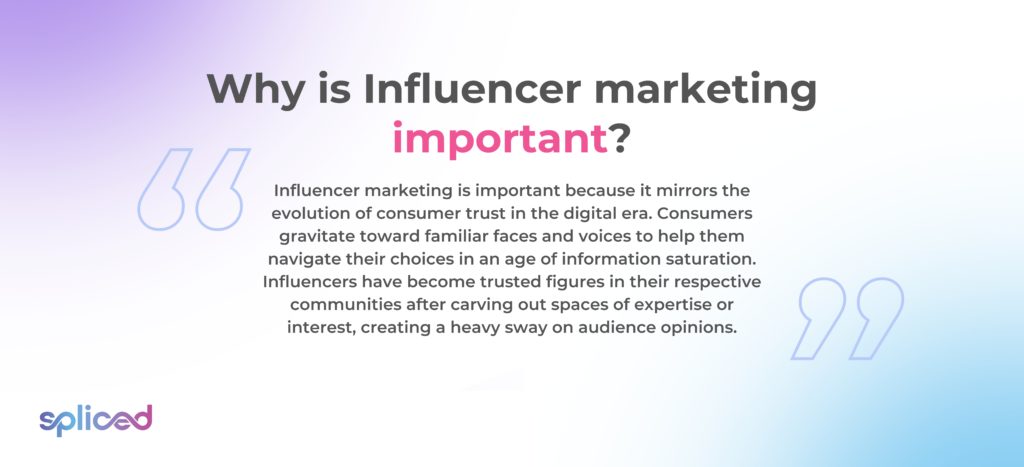
Why is Influencer marketing important?
Influencer marketing is important because it mirrors the evolution of consumer trust in the digital era. Consumers gravitate toward familiar faces and voices to help them navigate their choices in an age of information saturation. Influencers have become trusted figures in their respective communities after carving out spaces of expertise or interest, creating a heavy sway on audience opinions.
The rise of social media platforms has transformed how individuals communicate. Consumers are no longer passive recipients of information but active participants in discourse and dialogue. Influencer marketing acknowledges the shift by facilitating conversations rather than directing narratives.
Decision-making has changed in the digital era. Consumers value peer-to-peer interactions and look for recommendations from sources they perceive as genuine and unbiased. Influencers have an organic relationship with their followers, which has a significant sway on purchasing decisions.
Attention spans are dwindling nowadays, making competition fierce. Influencer marketing offers a more organic way to capture and sustain attention. The importance of influencer marketing is evident in its immediate impact on product endorsements and in its long-term effects on how consumers perceive authenticity and value.
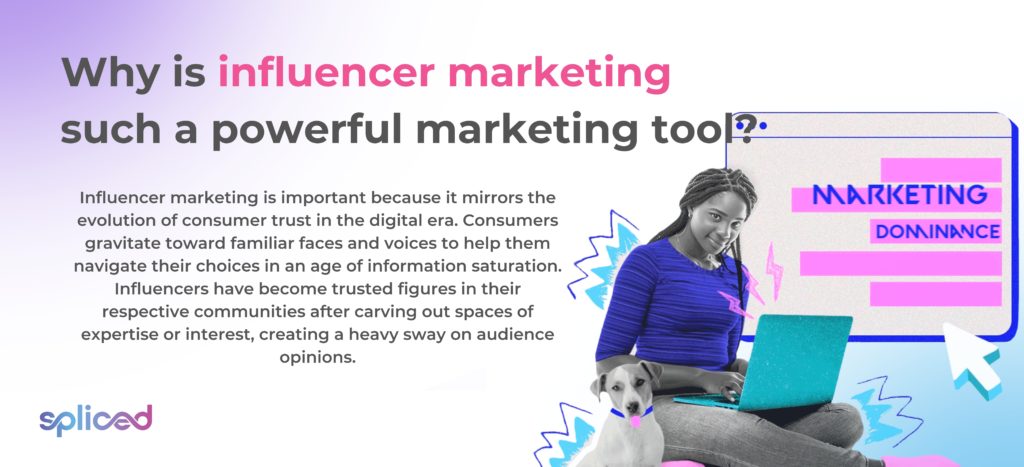
Why is influencer marketing such a powerful marketing tool?
The reason why influencer marketing is such a powerful marketing tool is because it leverages the trust and authenticity that internet personalities have cultivated. Influencers develop personal relationships with their followers over time, establishing a rapport that many traditional marketing strategies lack.
Consumers crave authentic and genuine interactions in today’s social media-centric age. Consumers prefer real information from real individuals, and influencers provide that genuine voice by showcasing products or services based on their personal experiences. Influencers are relatable, allowing prospective consumers to envision how the offering fits into their lives.
Influencers’ audiences view them as more approachable and trustworthy than faceless corporations because of the trust they have built. Another strength of influencer marketing is the power to target specific demographics. The versatility in influencer sizes, from macro-influencers with millions of followers to niche micro-influencers, enables brands to tailor ad campaigns to achieve precise marketing goals.
Influencers have direct engagement with their followers. The power of direct engagement increases the trust of audiences and deepens the relationship between them and the influencer. Influencers’ ability to harness trust is a powerful tool that results in profitability for brands with proper use.
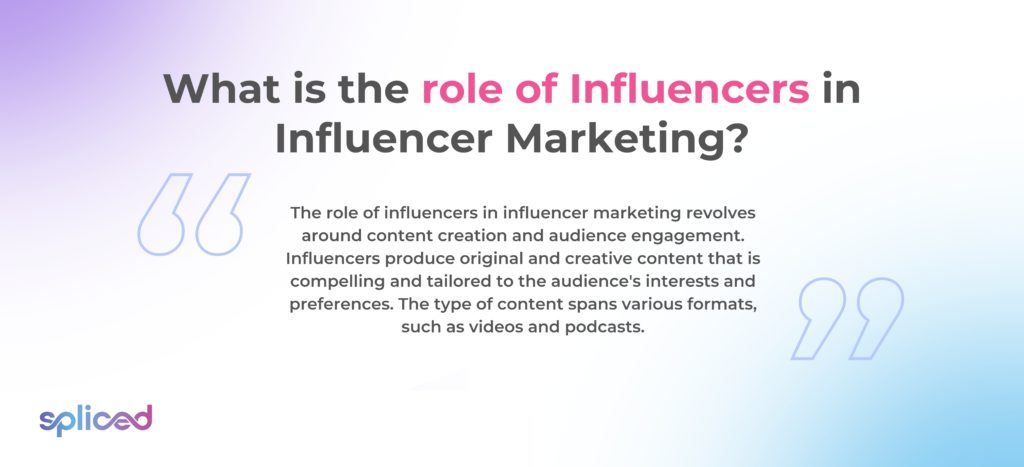
What is the role of Influencers in Influencer Marketing?
The role of influencers in influencer marketing revolves around content creation and audience engagement. Influencers produce original and creative content that is compelling and tailored to the audience’s interests and preferences. The type of content spans various formats, such as videos and podcasts.
Influencers foster a deep and genuine connection with their followers. They engage in meaningful conversations and answer queries while allowing feedback. Direct communication builds a relationship of trust and authenticity between influencers and their followers.
Influencers are brand collaborators. Influencers endorse the products and services of brands as part of the collaboration through their organic incorporation into the content being produced. The collaboration engages new users to discover the offerings of a brand through the firsthand experiences and testimonials shared by influencers. Influencer’s personal narratives and touchpoints offer a perspective that traditional marketing channels do not provide.
Influencers educate the audience regarding the features and nuances of a product or service, making it easier for the audience to grasp the offering. Influencers have a role in feedback collection. They provide brands with actual and real-time insights from users, aiding in the refinement of products or marketing strategies.
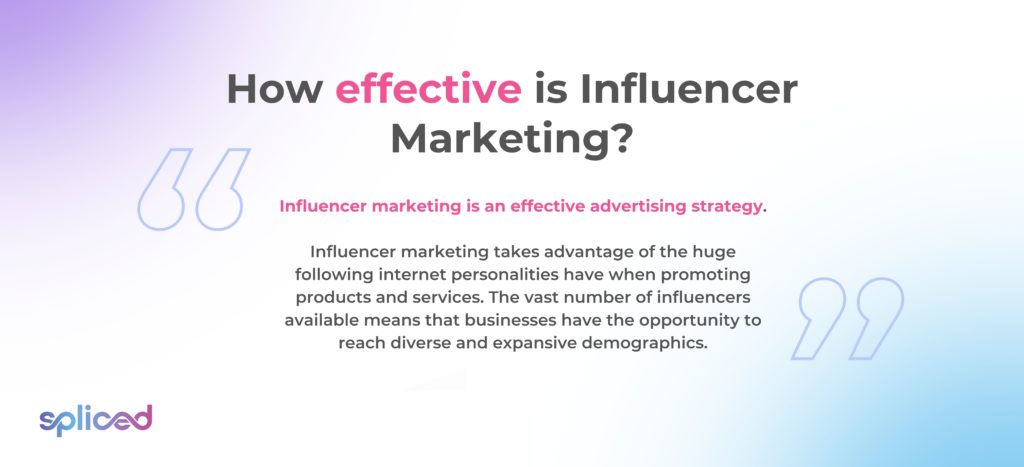
How effective is Influencer Marketing?
Influencer marketing is an effective advertising strategy. Influencer marketing takes advantage of the huge following internet personalities have when promoting products and services. The vast number of influencers available means that businesses have the opportunity to reach diverse and expansive demographics.
Influencer marketing has a good return on investment, or ROI. The digital age allows for precise tracking of where every marketing dollar goes. Many brands find that the ROI for influencer marketing is positive and outperforms other marketing channels. The partnership with the right and appropriate influencer for the brand yields multifold returns on the initial investment.
The increase in engagement rates serves as evidence of influencer marketing’s effectiveness. Higher engagement indicates an increase in interest and consideration for the product being endorsed. It represents the audience’s deep connection with the influencer, which, combined with high audience interest, increases the conversion rate.
Conversion rates measure the direct impact of an advertisement. A higher conversion rate means a large fraction of the audience took a desired action, such as purchasing a product or signing up for a newsletter. Influencer marketing is effective in driving desired actions at a rate that surpasses traditional advertising channels.
Influencer recommendations carry weight. Influencers have a loyal following, which gives their recommendations and opinions more weight. Audiences see influencers as friends they trust, which is a significant driving force for purchasing decisions.
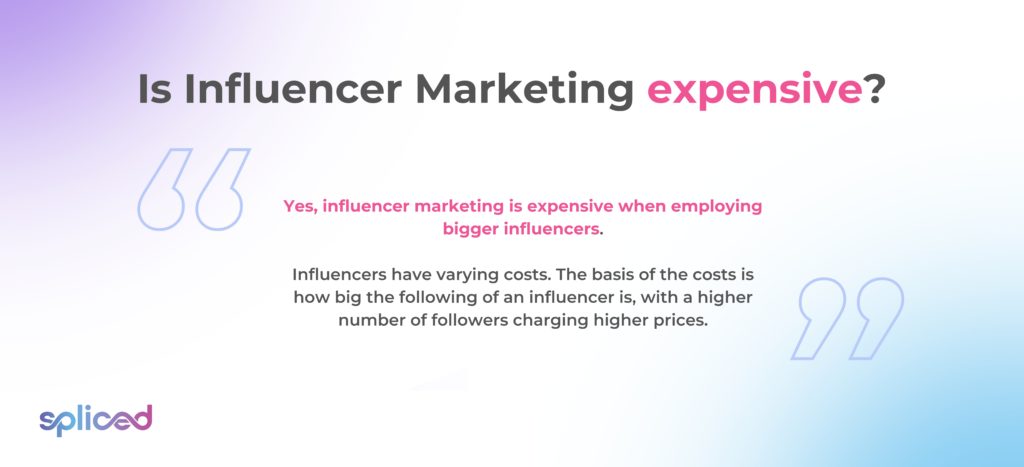
Is Influencer Marketing expensive?
Yes, influencer marketing is expensive when employing bigger influencers. Influencers have varying costs. The basis of the costs is how big the following of an influencer is, with a higher number of followers charging higher prices.
Nano-influencers are the smallest category. Nano-influencers have followers between 1,000 and 10,000 and charge between $10 and $100 for a single post. Such influencers have a tight-knit community and an audience with high engagement. The rates are the lowest among the four categories, making them an attractive option for smaller brands or those starting to experiment with influencer marketing.
The next category, micro-influencers, have followers between 10,000 and 50,000 and have prices set between $100 and $500 per post. Micro-influencers have a specific niche, and combined with their wider reach, they are an appealing option for brands seeking to take advantage of their specialized audience. Mid-tier influencers boast a following between 50,000 and 500,000.
Mid-tier influencers get $500 to $5,000 for each post. The increase in the sphere of influence is exponential, allowing brands to reach audiences nationwide or even worldwide. Macro-influencers are the biggest and most expensive, with a per-post price of at least $5,000 to take advantage of their 500,000 followers or more. Macro-influencers are perfect for brands with an international target market.
Influencer marketing becomes more expensive as the number of followers goes up. Brands need to evaluate their budget so it matches their target audience and campaign goals, helping select the right influencers for the ads. The costs are high for bigger influencers, but the return on investment in terms of reach and brand awareness is profitable for many big brands.
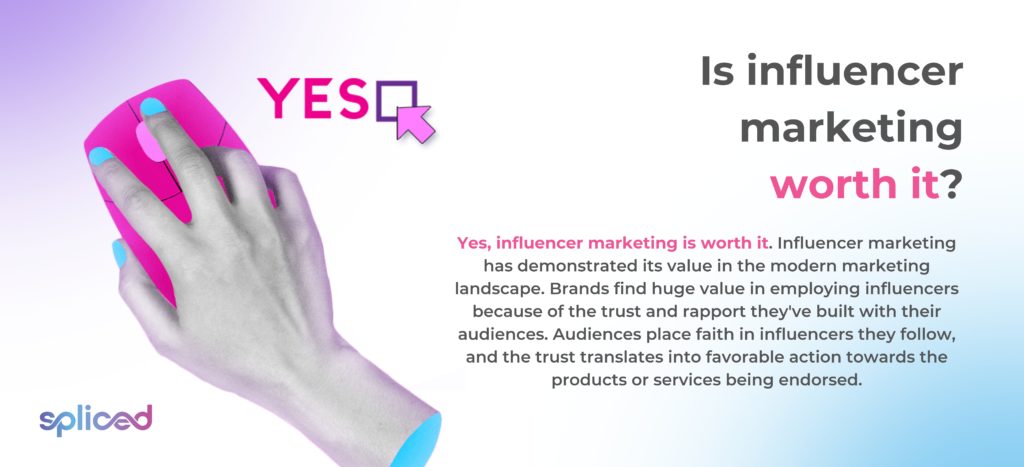
Is influencer marketing worth it?
Yes, influencer marketing is worth it. Influencer marketing has demonstrated its value in the modern marketing landscape. Brands find huge value in employing influencers because of the trust and rapport they’ve built with their audiences. Audiences place faith in influencers they follow, and the trust translates into favorable action towards the products or services being endorsed.
Another advantage of influencer marketing is the authenticity it brings. Traditional advertising methods have become predictable and less relatable. Influencers bridge the gap by providing a human touch, ensuring that promotional content feels organic and genuine. Influencers understand and speak the language of their audience, allowing product introductions to resonate even better.
Influencers create specific niches that come with a loyal following. The specificity of their audiences allows brands to target a particular demographic with increased effectiveness, which helps with the efficient spending of marketing budgets.
Influencer marketing has shown impressive and measurable return on investment figures in numerous campaigns. Data-driven insights reveal a noticeable uptick in engagement rates and conversions when an influencer provides a genuine endorsement of a product.
Influencer marketing, like any other strategy, demands careful planning. Brands must ensure the values between themselves and the influencers align. Working with an influencer that has a genuine and personal connection with the product leads to better results, while blind investment without proper research has led some brands astray.
Is Influencer Marketing part of Social Media Marketing?
Yes, influencer marketing is part of social media marketing. Social media marketing includes several tactics to promote products and brands. Social media influencer marketing is a strategy where famous personalities are employed to endorse the products being advertised. The primary goal of tapping into influencers is to utilize their vast following and credibility to reach a wider audience.
Influencers hold power in shaping public opinion. They have garnered trust from their followers over time and have established themselves as authorities in specific niches or industries. Brands and advertisers collaborate with influencers to capitalize on the trust and influence such individuals have built. Other social media marketing strategies include content creation and audience engagement.
Brands that understand the nuances of influencer marketing and harness its strengths have experienced a positive change in their marketing results. For example, in the fashion industry, a simple post by a fashion influencer wearing a particular brand’s outfit translates into significant sales as followers rush to emulate the look. Influencers bring visibility to a brand and give it a voice and a relatable narrative.
Influencer marketing generates a strong pull from users due to its authenticity and the reach it provides. Brands have realized that messages conveyed through trusted figures resonate more with audiences than traditional advertisements. Influencer marketing has allowed companies to leverage the expansive and built-in audiences and followers of such individuals.
